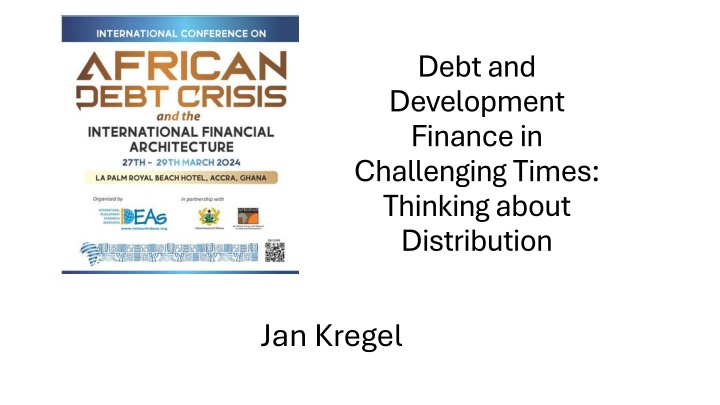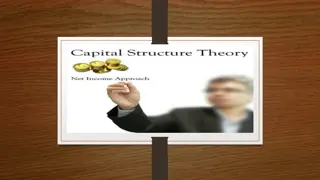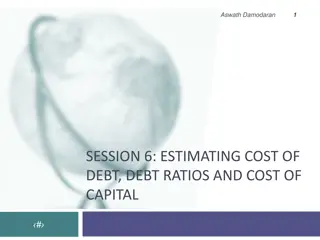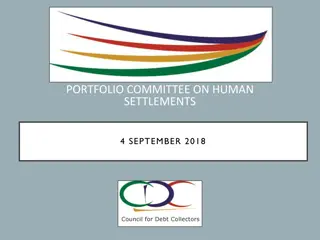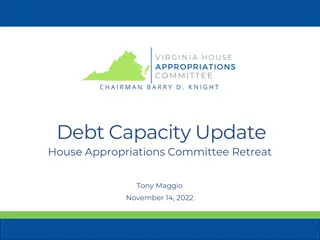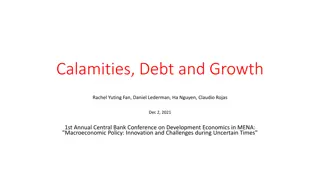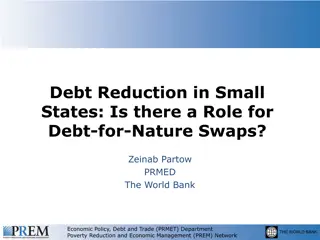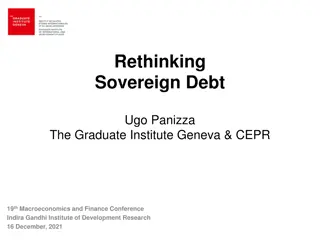Debt and Development Finance in Challenging Times: Distribution and Stability
Cognitive dissonance in post-war financial architecture, development finance targets, Bretton Woods objectives, and solutions for external imbalances in developing countries. Evolution from Development Decade to UNCTAD era, addressing stable exchange rates, structural policy industrialization, and private financial flows in a changing global framework.
Download Presentation

Please find below an Image/Link to download the presentation.
The content on the website is provided AS IS for your information and personal use only. It may not be sold, licensed, or shared on other websites without obtaining consent from the author.If you encounter any issues during the download, it is possible that the publisher has removed the file from their server.
You are allowed to download the files provided on this website for personal or commercial use, subject to the condition that they are used lawfully. All files are the property of their respective owners.
The content on the website is provided AS IS for your information and personal use only. It may not be sold, licensed, or shared on other websites without obtaining consent from the author.
E N D
Presentation Transcript
Debt and Development Finance in Challenging Times: Thinking about Distribution Jan Kregel
Cognitive Dissonance and Post War Financial Architecture Bretton Woods objective: Eliminate Beggar my Neighbour policies Stability of Exchange rates Stable rates of exchange in terms of $/Gold Think of a country as a bank: issuing national currency It has to guarantee the external value relative to $/Gold A private bank holds central bank reserves, the country holds $/Gold reserves The central bank can create domestic currency reserves But $/Gold reserves have to be earned through and external account surplus Or: Sales of domestic assets or foreign Borrowing or an IMF Program Stable Exchange Rate = Stable Foreign Reserve Balance= Balanced Multilateral Current Account
Cognitive Dissonance and Development Finance UN Development Decade (1961 linked to Alliance for Progress) UNCTAD I (1964) G-77 (UNCTAD II) Development Finance Target: 0.7% of Developed countries GDP to finance Developing countries purchase of developed country exports Developed country export surplus = Developing countries deficit Import led development =Debt based development = Borrow your way to development But Exchange rate stability requires External Balance within the limits of Forex reserves
From 1961 Development Decade to 1964 UNCTAD Bretton Woods based on assumption of stable exchange rates Stable Exchange rates require external account balance (Now called the External Account Constraint ) BUT: Developing countries have structural external imbalances That is the definition of a developing economy Represented by UPS: unbalanced productive structure (Diamand) Trend decline in terms of trade (Prebisch, Singer, Myrdal); Solutions: Earn your development through Structural policy industrialization: unlimited supplies of labour (Lewis) Building export sector --Preferential infant industry trade policies (Havana) Exchange rate policies: dual exchange rates (Diamand, Kaldor)
Post-Smithsonian: Flexible rates and Private flows Now Flexible but stable Exchange rates Change in the constraint Private Financial Flows to cover External Deficits No External Current Account Constraint You can always borrow from private markets to fund external deficit Private Capital inflow Depends on speculation Privatization of State Industry Domestic Market liberalization Interest rate differential carry trade Exchange rate anchor currency appreciation driven by capital inflows
DomarCapital Account Constraint If rate of interest on debt is higher than rate of increase of outstanding debt stock: debt/GDP ratio rises without limit But even if rate of interest on foreign borrowing is below or equal to rate of increase of outstanding debt stock and debt/GDP ratio stabilizes Domar/Minsky Rule: This is a PONZI Scheme Will Eventually lead to a financial crisis (even a decline in the rate of inflow falls but remains positive!) Replaces an IMF Austerity programme Domestic bank crisis and exchange rate crisis New External Constraint in a Capital Account Constraint Greenspan: (Mexico) Not a Current Account Crisis, A Capital Account Crisis
Where do these constraints come from Rosenstein Rodan development : solve the problem created by the new national economic boundaries after Versailles Disrupted existing productive structures (we now call them supply chain disruptions) Optimal production area optimal currency area optimal political area How to develope self-sustaining productive structures in these new economic areas By definition they had unbalanced productive structures First priority internal structural balance Then finance (on a risk diversified Regional financial trust) It required a Big Push, or a Big Bang or Balanced sectoral Approach This was no Soviet style quantitative planning! Based on substitution and complementarity in the Keynesian Multiplier
The simple solutions Remove external balance constraints Eliminate national boundaries: Regional trading areas Reduce trade impediments Remove financial constraint Capital controls (on inflows) Eliminate national currency Multiple Exchange rate regimes Eliminate exchange rates Create common area currency Replace the US$ with ?? But: International Financial Architecture is based on Bilateral Debt The problem is to remove the Ponzi finance of external constraints
Climate Damage Does not respect borders Climate Damage is a debt pusher it forces countries to borrow Banks create money out of nothing; climate change creates debt out of nothing Think of a hurricane as a mafia offer you can t refuse Or as a debt to Gaia accumulated over time Accumulates faster for countries with lower means to Remediate Geography: SIDS, Production: climate dependent Agriculture No Policy remedies: Good macro policies won t help Not only generates a Maldistribution of debt But also of populations, of water: drought, flood, turbulence We can do something about the people, not the water But emergency financing remains on a bilateral basis And remediation creates contingent debt with no debt service Is there an asset to match the Climate debt
How does this system deal with Climate Change? Remediation/Reparation of Environmental Damage For low-income countries requires extraordinary budget expenditures Think of the hurricane as the Sovereign Climate creditor and the country as the debtor And may require imports of foreign technology/materials: foreign borrowing This creates a contingent or double debt burden No SDRM is possible with the hurricane you have to pay now with emergency services and repairs So no temporal restructuring is possible No SDRM is possible with a foreign creditor since no exports generated It is pure Ponzi finance
Global MalDistributionof Fiscal Space While climate damage is random across borders, the fiscal space to respond and offset the internal costs is not. Developed countries have the fiscal space to use traditional Keynesian expenditure policies to support domestic incomes. But, as Lerner pointed out long ago, as long as debt is held internally the major impact is one of domestic redistribution of income; . The proper analogy to the incurrence of internally held national debt is not an individual borrowing from another individual but an individual borrowing money from one of his pockets to put it into another. But he also noted a basic difference between internal and external deficits: Increasing debt to other countries or to the citizens of other countries does indicate impoverishment of the borrowing country and enrichment of the lending country. The country cannot by monetary manipulations consume more than it can produce. repayment {of foreign currency debt} will constitute a real burden on the country just as the borrowing provided a real benefit quite different from any benefit that can accrue from internal borrowing. When the time comes to make the repayment there may be great inconvenience which could lead to default. But none of these considerations is at all applicable to internally held national debt which from the point of view of the nation cancels out. This means that there is a differential burden on developing countries responding to the crisis in terms of the real costs of servicing the external debt. While debt ratios have been further aggravated in all countries by the increasing interest rates led by developed countries central banks to offset the impact of these events on inflation rates, this further increasing the differential burden placed on developing related to developed countries.
Why Keynesian deficit spending wont work The conclusion is that the resolution to the remediation of climate damage via Keynesian policies is not the appropriate solution because it produces an inequitable burden across countries at different level of development without providing a solution to the real problems in the required structural adjustments. In simple terms the problems that are created by the impact of economic behaviour on the environment may be described more specifically as follows: A redistribution of global water supplies from continental ice to liquid ocean, from liquid oceans to atmospheric moisture to peak storm redistribution to flood or drought. A redistribution of arable land for food production A redistribution of the global population.
A transfer problem Keynes provides a suggestion on how to manage the problem: if our central controls succeed in establishing an aggregate volume of output corresponding to full employment as nearly as is practicable, the classical theory comes into its own again from this point onwards. If we suppose the volume of output to be given, i.e. to be determined by forces outside the classical scheme of thought, then there is no objection to be raised against the classical analysis of the manner in which private self-interest will determine what in particular is produced, in what proportions the factors of production will be combined to produce it, and how the value of the final product will be distributed between them . Thus, apart from the necessity of central controls to bring about an adjustment between the propensity to consume and the inducement to invest, there is no more reason to socialize economic life than there was before . If we substitute the words sustainable environment for aggregate volume of output corresponding to full employment and volume of output to be given we have When the supplies elasticities are not sufficiently high to produce structural adjustment or when the time constraint does not allow for market adjustment then the government is charged to intervene to provide the required changes in productive structure in which the private sector can continue to operate to determine what in particular will be produced. Government managing the adjustment may be impeded by the financial architecture the debts we are facing cannot be written off, and they are in general cross border which means transfers are impossible.
We are facing structural adjustment problems Schumpeter criticised Keynes General Theory for the simplifying assumption that the structure of production was independent of the level of effective demand. The analysis of the impact of demand on the sectoral composition of output was ignored. Yet, the resolution of the crises we face today will require changes in the economic structure, not in ensuring the full utilization of a given productive structure which is the objective of the Keynes s theory. The production structure was addressed by Keynes in How to Pay for the War, there the question was primarily the appropriate balance between saving and investment to reduce production of consumption relative to investment in military goods. Joan Robinson s elaboration of disguised unemployment broached the question of the sectoral distribution of employment when she noted that a shift in workers across sectors with productivity differentials could affect productivity and the definition of full employment output given the productive structure. It was left to VKRV Rao and others to extend this insight to analysis of developing economies in a model that was based on the sectoral structure of production that occurred when a manufacturing sector was created to absorb underemployed peasant labour. This process was eventually enshrined in Arthur Lewis classical model of unlimited supplies of labour.
Structural Adjustment? For the majority of the development pioneers a balanced production structure could be supported by government expenditure via the multiplier increasing productivity, focusing on the importance of changes in the sectoral composition of output to include manufacturing where the potential for innovation was greatest. The difficulty in achieving these changes in the structure of production was highlighted by the historical evolution of the terms of trade which led to discussion of the global structure of production in Myrdal s emphasis of cumulative causation and the Prebisch-Furtado theories of relations between the centre and periphery. This approach linked the changes in the domestic and international structures of production in the discussion of the international division of labour. Structural adjustments had to be global. The application of these issues was generalized in Marcelo Diamand s theory of Unbalanced Productive Structure. Diamand s message is not so much the imbalances in integrated processes of production which produce bottlenecks as it is the difficulty of market mechanisms to effectuate adjustment when faced with bottlenecks or other supply constraints. Both Lerner and Prebisch had already noted the importance of appropriate supply elasticities in the market process in adjustment to sectoral imbalances. Diamand applied this approach to the 1970s oil crisis where much as today there was little supply response to a substantial increase in prices so adjustment was to quantity of available resources; the corollary was a redistribution of income from the general population to the owner of the inelastic resource. If you need a visible confirmation, profits at Aramco, or any other energy company.
Burden sharing But, in the present context the common methods of dealing with the differential costs generated by the rising debt service is not available: debt forgiveness. No HIPIC process will solve the problems created by the pandemic-environmental- political catastrophes. The debts we are now dealing take the form of what we have borrowed from nature, in the form of environmental degradation, and which now have to be repaid. They are similar to unrequited or odious debt. Nature is not a creditor that can write off these debts, they have to be met. And they cannot be repaid in the normal sense, there is no transfer mechanism that allows this to take place as even the best COP proposals simple serve to stop the borrowing, to stabilize the borrowing from nature at some hypothetical level of temperature increase. And as Diamand and Lerner have emphasized there is no market mechanism to bring about the required measures. The best we can do is an equitable distribution of the costs and the current financial arrangements place an inequitable burden on developing countries because they do not have the required fiscal space, technical capacity and are required to resort to bilateral external financing.
Try an Old Idea Since the problem is not so much the costs of meeting the challenges of global climate change they have to be met and they are real, the basic problem is the global distribution of these costs created by the fact that developed countries can deal with them via creation of internal deficits and debt while this is not available to developing countries. This means the problem has to be dealt with on the level of a global financial institutions. We could think of this as designing the global financial system on the pattern of a domestic system, so the question is simply one of looking at the equitable distribution of costs between developed and developing countries. This would mirror the approach Keynes used for a global clearing union based on the extension of what he called the banking principle from the national to the international level. We can think of this as the mirror of Lerner s affirmation that government debt creating deficits cannot produce a real cost since there is always a necessary equality of debits and credits. In such a system, the debts and credits are always internal to the global clearing system.
How would Clearing Operate? Schumacher made an important amendments to Keynes Clearing plan It preserves national currencies, while eliminating the $ It eliminates bilateral debt relations, but retains multilateral balance: It does not require reserves or a capital base Easily implemented with digital currency technology Built on Layer One distributed ledger technology It opens the possibility for an International Investment Authority which could be dedicated to Environmental Sustainability
Schumacher Amendment: Multilateral Pool Clearing Schumacher proposes a system of Pool Clearing in which importers settle claims in national currency by transfer to their own National Clearing Fund who informs the National Clearing Fund of the exporter who makes payment in domestic currency of the exporter. The surplus receipts of the Pool of deficit countries will invest in domestic Treasury bills which will be held by an International Clearing Office as Trustee the Pools of surplus countries are deemed to own a share in the Pool of differentiated assets equal to the size of their respective surpluses. In this way, one might say, every national currency is made into a world currency, whereby the creation of a new world currency becomes unnecessary. Nor does the International Clearing Office in this connection require any special powers; it is not an agency for control, but a purely administrative body, the central accounting office for the different National Clearing Funds. The Clearing Pools of surplus countries become indebted to their internal money markets and acquire an equivalent share in the Pool; both their debt and their share in the Pool being equal to their trade surplus. The Clearing Funds of the deficit countries are left with cash balances (equal to their trade deficits) invested in domestic assets held by the International Pool. The main force is the fact that the holding of surpluses becomes unprofitable and risky. The surplus, instead of being convertible into gold or interest-earning investments, is tied up in the Pool: it is a share in the Pool. And the Pool s assets are always the weakest currencies of the world: the currencies of the countries that have been unable to earn as much as they have spent. In the present context the Clearing Office could become the financial agent of an International Investment Board or for a Commod management system
We now have the technology for global netting Digital currency Will it be public or private? Public: Central Bank Digital Currency Private Retail accounts held at central banks domestic automatic netting Central banks accounts held with a Global Clearing Union --automatic global netting ??? Do we need the central banks? They provide prudent regulation of private bank liabilities and bank reserves If CBDC accounts replace private bank liabilities: no need for Central Banks Could be done by National Treasury/Finance Ministries They all hold clearing accounts with the Clearing Union Democratic creation of liquidity via national budgets Preserves national currencies
Or Private? A proven private sector clearing system patterned on Keynes s proposal already exists
Thank you Read more on Modern Applications of the Clearing Union Approach at jankregel.org
